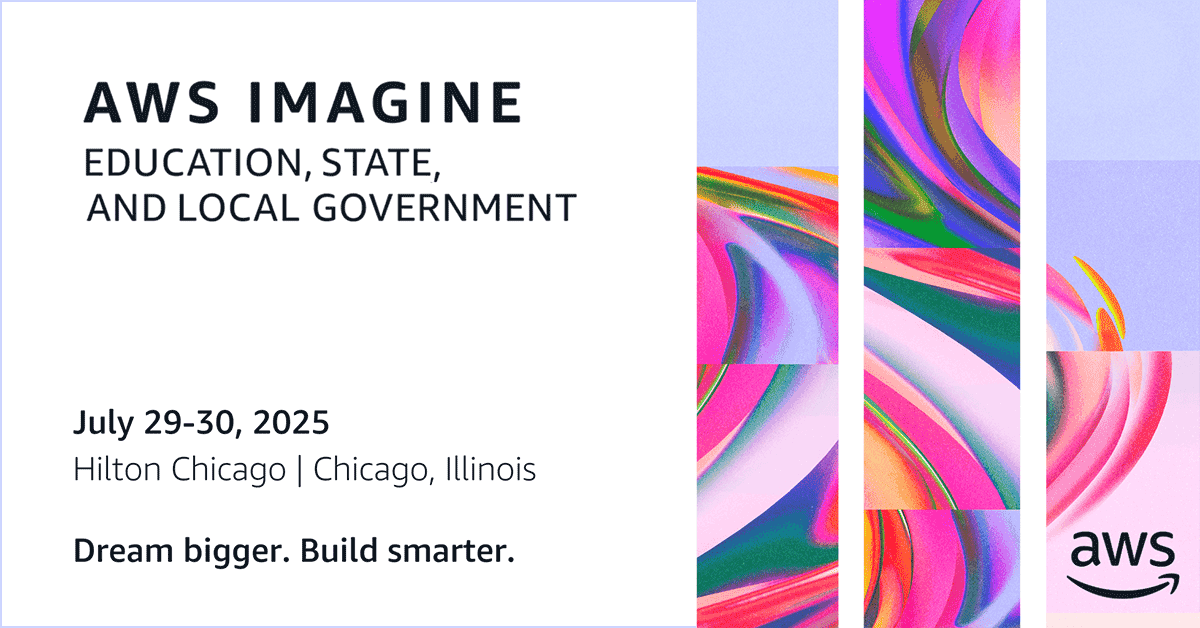Reimagining Higher Education with AI: Highlights from AWS Imagine 2025
Senior Analyst

The AWS Imagine 2025 Conference in Chicago offered a window into how artificial intelligence, cloud infrastructure, and industry-academic collaboration are reshaping the future of education. From state-wide data strategies to personalized learning bots and AI-driven student success platforms, the sessions illuminated the magnitude and urgency of transformation across K-12, higher education, and public sector institutions.
Let’s explore some key insights:
1. AI as Catalyst: From Career Readiness to Institutional Strategy
AI is no longer just an emerging tool; it’s becoming the intellectual infrastructure of modern education. Illinois Tech’s President Raj Echambadi captured this shift by reframing AI as a “thought catalyst” and “exoskeleton for the intellect.” Echoing this, multiple institutions emphasized that preparing students for AI-enhanced futures requires more than coding skills. It demands moral reasoning, empathy, entrepreneurialism, and systems thinking.
At the heart of this transformation is a redefinition of career readiness:
- City Colleges of Chicago and Illinois Tech introduced Runway 606, a K–Master’s cybersecurity pipeline where students can graduate high school with associate degrees.
- IBM and AWS are embedding industry-grade tools into college curricula, preparing students with real-time skills aligned with job market demand.
- Government agencies like the Illinois Dept. of Innovation and Technology are modernizing public service roles through Pluralsight-driven upskilling and AI-enabled hackathons.
These examples point to a convergence of education, industry, and public service where learning is dynamic, iterative, and deeply embedded in real-world challenges.
2. Data, Personalization, and 24/7 Engagement at Scale
The University of St. Thomas, North Carolina’s Employment Security Division, and the City of Miami Beach illustrated how centralized data platforms enable personalized, data-driven engagement.
- AWS Lake Formation allowed the University of St. Thomas to build a real-time data lakehouse that updates student records across platforms, from Canvas to ERP, while tracking retention metrics down to assignment interactions.
- North Carolina deployed the first state GenAI chatbot in early 2025, handling 30% of claim calls and setting a benchmark for responsive public services.
- Miami Beach’s data strategy showed how consolidating legacy tech stacks leads to agility and citizen-centered service.
Key takeaways:
- Business-led technology initiatives succeed where IT becomes the enabler, not the driver.
- 24/7 support and intelligent automation (chatbots, self-help tools, SMS pilots) meet users where they are geographically, linguistically, and technologically.
3. Cloud Innovation Centers and Student-Led Civic Tech
One of the most inspiring stories came from the AWS Cloud Innovation Centers (CICs), where students rapidly prototype civic tech solutions in just 6–10 weeks. At University of Pittsburgh, students developed:
- A diving analytics platform that cuts 3-hour video review sessions down to 20 minutes.
- A Board Meeting Summarizer for Los Angeles schools, reducing 2-day workflows to 40-minute AI-assisted summaries at a $5 cost.
These projects underscore three major themes:
- AI democratizes development: Students using Bedrock are delivering production-grade prototypes.
- Open source accelerates equity: CIC solutions are released publicly, supporting a virtuous cycle of shared innovation.
- Skills transformation: Students described AI tools as productivity multipliers, with implications for workforce pipelines far beyond their institutions.
4. Leadership and Change Management in the Age of AI
From Stanford and UCLA to Stellar Virtual and Maryville University, leaders emphasized that AI transformation begins with mission alignment and intentional culture change.
- UCLA Anderson implemented production AI in fundraising and grading. CIO Howard Miller emphasized reframing AI as an enabler of meaningful work, not a job threat.
- Stellar Virtual, operating K–12 schools in 8 states, embedded curriculum-aware AI bots that redirect students to content-specific learning paths.
- Stanford Online is testing AI concierges, tutors, and content creators while crafting an AI ethics and advisory framework.
These initiatives show that success requires:
- Clear tone-from-the-top communication.
- Faculty support and FOMO-driven adoption through visible wins.
- Strategic partnerships with AWS and others to accelerate change without recreating the wheel.
5. Rebuilding Education’s Infrastructure from the Ground Up
The keynote’s metaphor, likening the current wave of AI transformation to Chicago’s resurgence after the Great Fire of 1871, was not just symbolic; it was a call to action. It framed AI not as a tool for incremental improvement, but as a once-in-a-generation opportunity to rethink and reconstruct the very foundations of education and government services from the ground up.
- Cornell University’s AI strategy featured a campus-wide listening tour, hackathons, and advisory councils. This resulted in a 40% increase in operational efficiency in some use cases and deep faculty engagement.
- Michigan and North Carolina are breaking down institutional silos with enterprise data strategies and building capacity for real-time learning analytics.
- Wisconsin’s Department of Revenue used Amazon Connect to save 60% in call center costs and eliminate outages altogether, turning a bureaucratic function into a responsive service.
These case studies demonstrate that transformation through AI is not just about tools; it’s about people, purpose, and policy alignment.
Final Thoughts: AI is the Great Equalizer—If We Let It Be
LeVar Burton’s keynote discussion reminded attendees of the moral imperative behind this transformation. “Make children the priority,” he urged, emphasizing that AI’s true promise lies in accessibility, not monetization.
The AWS Imagine 2025 Conference reinforced a critical point: the future of education isn’t being built in isolation. It’s being co-created by public servants, technologists, students, and visionary leaders working together to design an equitable, AI-augmented future.
You May Also Like:
Categories
Share Article:

Other Posts From this Author:
© Copyright 2025, The Tambellini Group. All Rights Reserved.